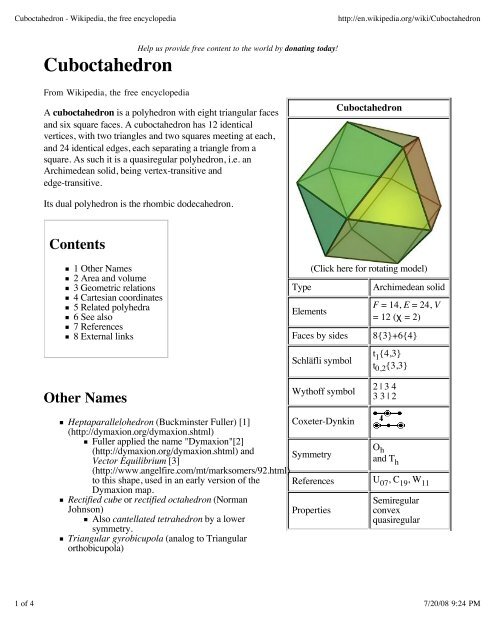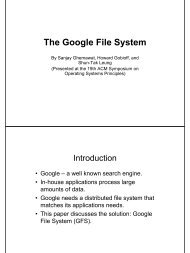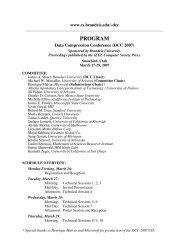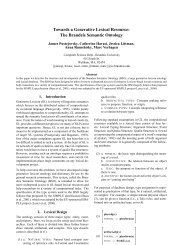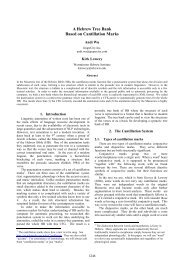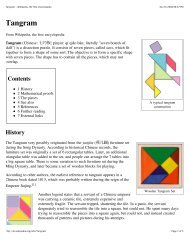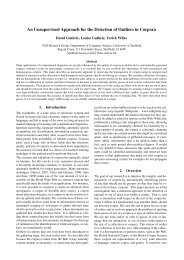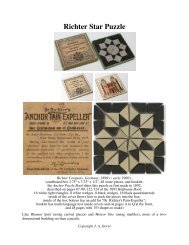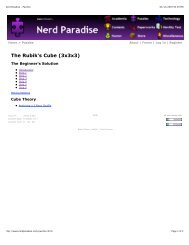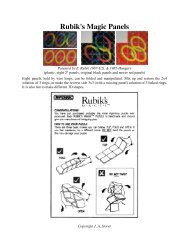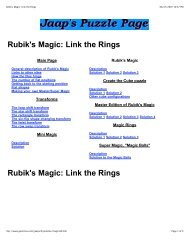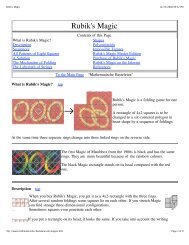Cuboctahedron - Wikipedia, the free encyclopedia
Cuboctahedron - Wikipedia, the free encyclopedia
Cuboctahedron - Wikipedia, the free encyclopedia
Create successful ePaper yourself
Turn your PDF publications into a flip-book with our unique Google optimized e-Paper software.
<strong>Cuboctahedron</strong> - <strong>Wikipedia</strong>, <strong>the</strong> <strong>free</strong> <strong>encyclopedia</strong> http://en.wikipedia.org/wiki/<strong>Cuboctahedron</strong><br />
<strong>Cuboctahedron</strong><br />
From <strong>Wikipedia</strong>, <strong>the</strong> <strong>free</strong> <strong>encyclopedia</strong><br />
A cuboctahedron is a polyhedron with eight triangular faces<br />
and six square faces. A cuboctahedron has 12 identical<br />
vertices, with two triangles and two squares meeting at each,<br />
and 24 identical edges, each separating a triangle from a<br />
square. As such it is a quasiregular polyhedron, i.e. an<br />
Archimedean solid, being vertex-transitive and<br />
edge-transitive.<br />
Its dual polyhedron is <strong>the</strong> rhombic dodecahedron.<br />
Contents<br />
1 O<strong>the</strong>r Names<br />
2 Area and volume<br />
3 Geometric relations<br />
4 Cartesian coordinates<br />
5 Related polyhedra<br />
6 See also<br />
7 References<br />
8 External links<br />
O<strong>the</strong>r Names<br />
Help us provide <strong>free</strong> content to <strong>the</strong> world by donating today!<br />
Heptaparallelohedron (Buckminster Fuller) [1]<br />
(http://dymaxion.org/dymaxion.shtml)<br />
Fuller applied <strong>the</strong> name "Dymaxion"[2]<br />
(http://dymaxion.org/dymaxion.shtml) and<br />
Vector Equilibrium [3]<br />
(http://www.angelfire.com/mt/marksomers/92.html)<br />
to this shape, used in an early version of <strong>the</strong><br />
Dymaxion map.<br />
Rectified cube or rectified octahedron (Norman<br />
Johnson)<br />
Also cantellated tetrahedron by a lower<br />
symmetry.<br />
Triangular gyrobicupola (analog to Triangular<br />
orthobicupola)<br />
<strong>Cuboctahedron</strong><br />
(Click here for rotating model)<br />
Type Archimedean solid<br />
Elements<br />
F = 14, E = 24, V<br />
= 12 (χ = 2)<br />
Faces by sides 8{3}+6{4}<br />
Schläfli symbol<br />
Wythoff symbol<br />
Coxeter-Dynkin<br />
Symmetry<br />
References<br />
Properties<br />
t 1 {4,3}<br />
t 0,2 {3,3}<br />
2 | 3 4<br />
3 3 | 2<br />
O h<br />
and T h<br />
U 07 , C 19 , W 11<br />
Semiregular<br />
convex<br />
quasiregular<br />
1 of 4 7/20/08 9:24 PM
<strong>Cuboctahedron</strong> - <strong>Wikipedia</strong>, <strong>the</strong> <strong>free</strong> <strong>encyclopedia</strong> http://en.wikipedia.org/wiki/<strong>Cuboctahedron</strong><br />
Area and volume<br />
The area A and <strong>the</strong> volume V of <strong>the</strong> cuboctahedron of edge<br />
length a are:<br />
Geometric relations<br />
A cuboctahedron can be obtained by taking an appropriate<br />
cross section of a four-dimensional cross-polytope.<br />
A cuboctahedron has octahedral symmetry. Its first stellation<br />
is <strong>the</strong> compound of a cube and its dual octahedron, with <strong>the</strong><br />
vertices of <strong>the</strong> cuboctahedron located at <strong>the</strong> midpoints of <strong>the</strong><br />
edges of ei<strong>the</strong>r.<br />
The cuboctahedron is a rectified cube and also a rectified octahedron.<br />
Colored faces<br />
Rhombic<br />
dodecahedron<br />
(dual polyhedron)<br />
3.4.3.4<br />
(Vertex figure)<br />
It is also a cantellated tetrahedron. With this construction it is given <strong>the</strong> Wythoff Symbol: 3 3 | 2.<br />
A skew cantellation of <strong>the</strong> tetrahedron produces a solid with faces parallel to those of <strong>the</strong> cuboctahedron,<br />
namely eight triangles of two sizes, and six rectangles. While its edges are unequal, this solid remains<br />
vertex-uniform: <strong>the</strong> solid has <strong>the</strong> full tetrahedral symmetry group and its vertices are equivalent under that<br />
group.<br />
The edges of a cuboctahedron form four regular hexagons. If <strong>the</strong> cuboctahedron is cut in <strong>the</strong> plane of one<br />
of <strong>the</strong>se hexagons, each half is a triangular cupola, one of <strong>the</strong> Johnson solids; <strong>the</strong> cuboctahedron itself thus<br />
can also be called a triangular gyrobicupola, <strong>the</strong> simplest of a series (o<strong>the</strong>r than <strong>the</strong> gyrobifastigium or<br />
"digonal gyrobicupola"). If <strong>the</strong> halves are put back toge<strong>the</strong>r with a twist, so that triangles meet triangles<br />
and squares meet squares, <strong>the</strong> result is ano<strong>the</strong>r Johnson solid, <strong>the</strong> triangular orthobicupola.<br />
Both triangular bicupolae are important in sphere packing. The distance from <strong>the</strong> solid's centre to its<br />
vertices is equal to its edge length. Each central sphere can have up to twelve neighbors, and in a<br />
face-centered cubic lattice <strong>the</strong>se take <strong>the</strong> positions of a cuboctahedron's vertices. In a hexagonal<br />
close-packed lattice <strong>the</strong>y correspond to <strong>the</strong> corners of <strong>the</strong> triangular orthobicupola. In both cases <strong>the</strong> central<br />
sphere takes <strong>the</strong> position of <strong>the</strong> solid's centre.<br />
Cuboctahedra appear as cells in three of <strong>the</strong> convex uniform honeycombs and in nine of <strong>the</strong> convex<br />
uniform polychora.<br />
The volume of <strong>the</strong> cuboctahedron is 5/6 of that of <strong>the</strong> enclosing cube and 5/8 of that of <strong>the</strong> enclosing<br />
2 of 4 7/20/08 9:24 PM<br />
Net
<strong>Cuboctahedron</strong> - <strong>Wikipedia</strong>, <strong>the</strong> <strong>free</strong> <strong>encyclopedia</strong> http://en.wikipedia.org/wiki/<strong>Cuboctahedron</strong><br />
octahedron; it is 5/3 √2 times <strong>the</strong> cube of <strong>the</strong> length of an edge.<br />
Cartesian coordinates<br />
The Cartesian coordinates for <strong>the</strong> vertices of a cuboctahedron (of edge length √2) centered at <strong>the</strong> origin are<br />
(±1,±1,0)<br />
(±1,0,±1)<br />
(0,±1,±1)<br />
Related polyhedra<br />
Cube Truncated cube cuboctahedron Truncated octahedron Octahedron<br />
See also<br />
Cube<br />
Icosidodecahedron<br />
Octahedron<br />
Rhombicuboctahedron<br />
Truncated cuboctahedron<br />
References<br />
Williams, Robert (1979). The Geometrical Foundation of Natural Structure: A Source Book of<br />
Design. Dover Publications, Inc. ISBN 0-486-23729-X. (Section 3-9)<br />
External links<br />
The Uniform Polyhedra (http://www.mathconsult.ch/showroom/unipoly/)<br />
Virtual Reality Polyhedra (http://www.georgehart.com/virtual-polyhedra/vp.html) The Encyclopedia<br />
of Polyhedra<br />
Eric W. Weisstein, <strong>Cuboctahedron</strong> (Archimedean solid) at MathWorld.<br />
Retrieved from "http://en.wikipedia.org/wiki/<strong>Cuboctahedron</strong>"<br />
Categories: Archimedean solids | Quasiregular polyhedra<br />
This page was last modified on 9 April 2008, at 17:42.<br />
All text is available under <strong>the</strong> terms of <strong>the</strong> GNU Free Documentation License. (See Copyrights for<br />
details.)<br />
3 of 4 7/20/08 9:24 PM
<strong>Cuboctahedron</strong> - <strong>Wikipedia</strong>, <strong>the</strong> <strong>free</strong> <strong>encyclopedia</strong> http://en.wikipedia.org/wiki/<strong>Cuboctahedron</strong><br />
<strong>Wikipedia</strong>® is a registered trademark of <strong>the</strong> Wikimedia Foundation, Inc., a U.S. registered 501(c)(3)<br />
tax-deductible nonprofit charity.<br />
4 of 4 7/20/08 9:24 PM


